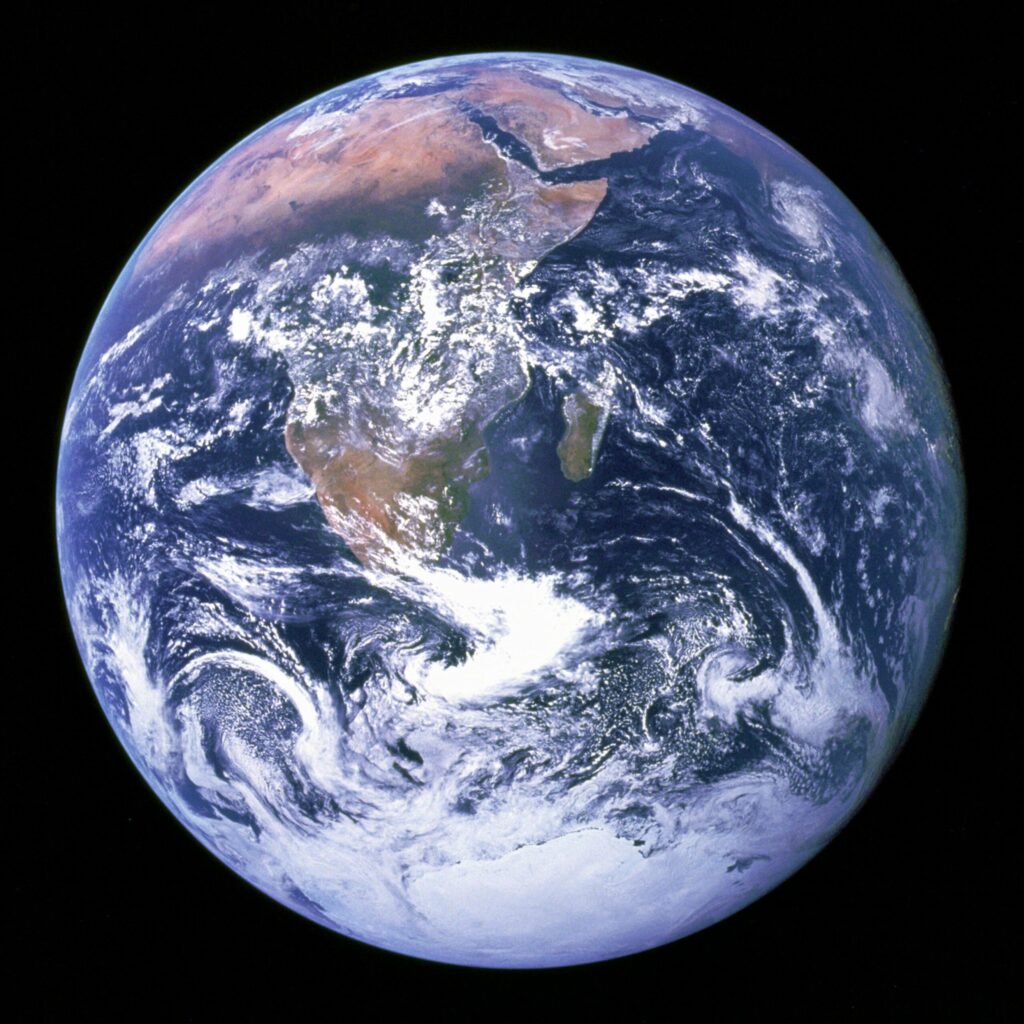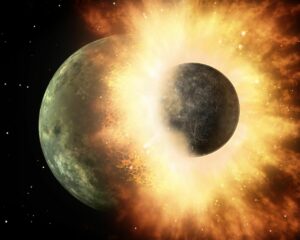1.1 The Earth in Space
The Earth is a planetary oasis in the cold near-vacuum of space. The lifeless Moon is 30 Earth-diameters away (approximately 385,000 km). Mars—the nearest planet—is 9,000 Earth-diameters away (at its closest) and there is effectively no exchange of matter or energy between the Earth and either of these bodies—except as described in Box 1.1. In an atomic sense, virtually everything that’s here now has been here for all of the last 3 billion years of Earth’s existence (see Box 1.2), and relatively little matter enters or leaves. In other words, the Earth is a closed system with respect to matter: effectively nothing is added or taken away. However, the Earth is not a closed system in terms of energy. We receive a significant amount of radiant energy from the sun, and of course, without that, we could not live here. We also emit some radiant energy into space, both as reflected sunlight, and as radiated infrared light from the warm surfaces of the Earth.
The Earth has strong ocean tides because of variations in the gravitational pull of the Moon (and also the sun). As described in Chapter 9, we can harness some of that energy using tidal barrages and tidal-current turbines. The lunar and solar tidal forces also have some effect in the Earth’s interior as their variations produce small deformations of the material of the mantle and core, and the friction associated with those is converted to heat. (This effect is well illustrated on Jupiter’s moon Io, which is actively volcanic because of the tidal effects of the giant planet.)
The iconic 1972 Apollo 17 photograph of Earth, taken from about 1/12th of the way to the moon (Figure 1.1.1), has been reproduced more than almost any other photo, and has had a strong effect on billions of people. It is the first ever photo that provides a fully illuminated view of the Earth from space (as opposed to a crescent, for example), and it’s the last such photo taken by a human (the NASA moon-landing program was cancelled after Apollo 17). The image of a brightly sun-lit, and vigourously active and “alive” Earth, surrounded by the apparent empty blackness of space, highlights the extraordinary isolation, uniqueness and significant fragility of our planet. In the 1970s and 80s this image played a role in the growth of environmentalism, and also in the development of the concept of the Earth as a system.

There are some important features to observe in that 1972 image, such as the dark blue of the vast oceans, the dry sandy Sahara in northern Africa, the frozen expanse of Antarctica, and the swirling clouds obscuring the green equatorial region of Africa. Sunlight is reflecting brightly from high-albedo surfaces (ice and clouds), moderately from lower-albedo surfaces (desert sand and vegetation) and very little from the low-albedo surface of the oceans. In this image it is almost possible to visualize the interactions taking place between the different components of the Earth.
Box 1.2 Incoming!
The Earth formed from the accumulation of rocky debris that existed within the radius of our orbit from the sun. That started with the Early Bombardment, from around 4.6 Ga to about 4.1 Ga. During that time there was ongoing accumulation of material to make up the Earth’s mass. There was also one massive collision with a planet about the size of Mars (or about one-eighth the volume of Earth) (Figure 1.1.2)

at about 4.5 Ga. Some of the material from that collision was blasted into Earth orbit and eventually coalesced to form the Moon. The Early Bombardment was followed by the Late Heavy Bombardment, which peaked at around 3.9 Ga, and gradually decreased in intensity until around 3.0 Ga.
The present rate of accumulation of extra-terrestrial material on Earth is insignificant. Each year we receive around 14,000 tonnes of material from space, mostly as dust-sized particles. That is equivalent to about 1/400,000,000,000,000,000,000th of Earth’s mass per year, or about 1/400,000,000,000th of Earth’s mass over the past billion years.
Media Attributions
- Figure 1.1.1 NASA public domain image of Earth seen from Apollo, via Wikimedia Commons, https://commons.wikimedia.org/wiki/File:The_Earth_seen_from_Apollo_17.jpg
- Figure 1.1.2 NASA public domain image, Planetary Smash-up, https://www.nasa.gov/multimedia/imagegallery/image_feature_1454.html
